Compared with traditional welding methods, laser welding has significant advantages – low heat input, fast welding speed, small heat-affected zone,
In recent years, laser welding has been widely used in the automotive industry, shipbuilding industry, nuclear power industry, aerospace
Aviation industry and other high-tech industries are more and more widely used, and with the reduction of the cost of complete sets of equipment, in the daily hardware supplies
And other life-related applications began to grow rapidly. But at the same time, single laser welding also has certain shortcomings,
Can not meet the more and more diverse needs: first, single laser welding on the weld assembly gap requirements are very strict,
It is usually required to have a gap < 0.2mm, otherwise it is difficult to achieve a good connection; Second, single laser welding is highly sensitive to welding cracks
It is very easy to cause weld cracking, and the composition of the weld can not be adjusted to control the generation of cracks; Third, single
Laser welding requires ultra-high power lasers when welding large thickness plates, and its penetration ability depends entirely on the power of the laser
And the weld quality can not be fully guaranteed.
In order to meet the needs of the development of various industries, the methods of laser welding have also been improved, and the corresponding development has been developed, such as this article
The laser wire filling welding and other welding methods are described. Laser wire filling welding is developed on the basis of single laser welding,
Compared with single laser welding, it has obvious advantages:
① Greatly reduce the assembly requirements of the workpiece, because the welding wire is added to the welding process, the weld pool metal will be greatly increased and can be bridged
Connect with a larger weld gap, while making the weld more full;
The microstructure properties of the weld area can be controlled, because the composition of the welding wire is different from that of the base material of the weld joint
After the wire is fused into the weld pool, the quality, composition and proportion of the weld pool can be adjusted to control the solidification process and the formation of microstructure.
(3) The line energy input is small, the heat affected zone and thermal deformation are small, which is very conducive to welding the workpiece with strict deformation requirements;
④ can achieve smaller laser power welding thicker materials, because the welding wire is added to the welding process, multiple welding can be achieved, and
The weld pool metal will be significantly enlarged, so that the weld joint can be opened to reduce the actual size of the weldment
Laser welding thickness, and then realize multi-channel laser wire welding thick plate material.
The difference between laser wire welding and laser wire welding
The form of laser wire filler welding is shown in Figure 1, which is different from the laser wire filler brazing shown in Figure 2. The basic elements of both welding methods are
Consistent, are composed of a laser beam, welding wire, welding parts, protective gas according to actual needs to decide whether to add, involved
And the main equipment are wire feeding machine, welding machine, wire filler welding soft gun head, welding head, high power laser.
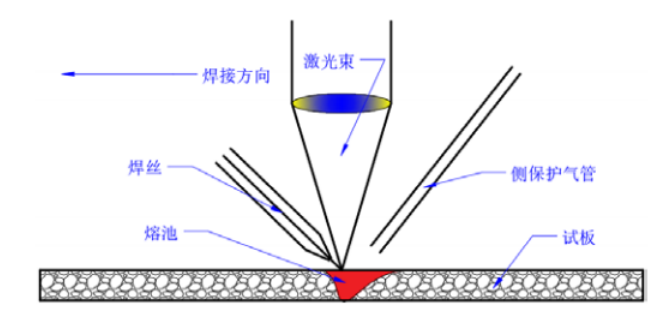
Figure 1 Laser wire fusion welding

Figure 2 Laser wire brazing
Although there is basically no difference in the external form of the two welding methods, there is a significant difference in essence. When laser wire welding,
The laser generally uses a high-power fiber laser, as shown in Figure 3, the laser not only needs a welding wire, but also needs to melt the base metal and in
The special hole effect of laser deep penetration welding is formed on the base metal, forming a deep melting pool, and the composition of the welding wire is fully mixed with the metal composition of the base metal
A new hybrid molten pool is formed, and the element composition, proportion and quality of the hybrid molten pool are larger than that of the welding wire and the base material
Therefore, the appropriate welding wire can be added to the welding process according to the performance defects of the base material itself, so as to improve the welding efficiency
On the view level, the crack resistance, fatigue resistance, corrosion resistance, wear resistance and other aspects of the weld are purposefully improved. besides
In addition, laser wire welding can be multi-channel stacked welding, because it can achieve deep penetration welding with small hole effect, which can be achieved
The full fusion of the bottom two layers of the weld bead avoids serious defects of non-fusion, so that it has the ability to weld large thickness joints.
When laser wire brazing, the laser generally uses a high-power semiconductor laser, as shown in Figure 4
On the welding wire, only a very small amount of laser will act on the weld and melt a small amount of metal on the surface of the weld, and the melt pool is almost melted by melting
The welding wire is formed, so the weld performance mainly depends on the elemental composition and proportion of the welding wire and the melted welding wire at the weld
The main purpose of laser wire brazing is to achieve a certain connection strength of the weld joint
And sealing, and laser wire brazing can not be multi-channel stacked welding, the upper and lower two layers of the weld basically can not be solid
Now fully and effectively fused, the mechanical properties of the joint are very poor.
Application field of laser wire welding
With the development of laser wire filler welding technology and the increase of laser power limit, the application range of laser wire filler welding
More and more extensive, mainly in the following aspects:
Laser wire welding of aluminum alloy
In general, because the aluminum alloy itself has a high reflectivity to the laser and a high thermal conductivity, the aluminum alloy is laser welded
When the laser power required is large, this will lead to low boiling point elements in aluminum alloys (such as Mg, Zn, etc.) serious evaporation and burning loss,
At the same time, the low surface tension of the molten pool metal affects the solidification characteristics of the weld, and these reasons will lead to the existence of laser welding aluminum alloys
Many problems – poor mechanical properties of weld joints, poor weld forming, porosity and cracks serious. Instead, a laser is used to fill the wire
Welding aluminum alloy will significantly improve these problems:
① laser wire welding can improve the depression of the weld surface, effectively improve the weld Type, and the welding process splash is small;
② The addition of welding wire can not only affect the crystal orientation of cylindrical crystals in the weld, but also dilute the weld he crystalline interface generated by the relative growth of the core columnar crystal improves the weld forming, and also improves the absorption rate of the material to the laser.
With the increase of melting width, the microhardness decreases slightly, and the tensile strength and elongation of the joint will be significant under the optimized process parameters
Improve; (3) Welding with appropriate process parameters can obtain no obvious internal defects, microhardness of HV60 or more, and joint HAZ
There is no obvious softening of the weld joint in the zone, and the fracture is in the base material area during tensile test.
Laser wire welding of dissimilar metals
For some demanding working environments or based on cost considerations, it is often necessary to have multiple aspects of a workpiece at the same time
Special properties, such as corrosion resistance, high specific strength, heat resistance, wear resistance, high conductivity, good heat dissipation, etc., but the vast majority
Metal materials can not have a number of more prominent special properties at the same time, and metal materials with special properties are often
Scarce and expensive, can not be used in large quantities, so if you can make a variety of materials with special properties to achieve effective connection, then
May meet the use requirements. The difference in physical and chemical properties of dissimilar metal materials is generally large, which is inevitable in the welding process
The formation of intermetallic compounds, which have a great impact on the performance of weld joints, brittle intermetallic compounds will make the weld very easy to produce
It is very difficult to directly use a single laser to weld dissimilar metal joints, and its process stability is difficult to control
Difficulty in reproduction. A large number of scholars and experts have found that laser wire welding is relatively good for welding dissimilar metals, and the choice is appropriate
The filler wire can inhibit the formation of intermetallic compounds to a certain extent, and can greatly improve the mechanics of welded joints
Performance:
① Mg/Cu lap joint welded by laser wire filling welding can be formed well under appropriate process parameters The maximum shear strength of dissimilar metal joints with certain strength can reach 164.2MPa, which is 64% of the magnesium alloy base metal.
② The welding of Al/Ti lap joint and butt joint is studied, and the results show that the welding process is stable and formed when rectangular light spot is used Beautiful, wide range of process parameters, high weld quality, its maximum tensile strength reaches 94% of the aluminum alloy base metal; Improve weld forming.For workpieces with bearing purposes, if the weld collapses, its effective thickness will be reduced, and the mechanical properties will be reduced if the weld bites
It will lead to stress concentration at the edge of the weld, and the mechanical properties will be reduced. For the workpiece with appearance requirements, if the weld collapses
Snagging or biting the edge can have a serious visual impact and is unacceptable. In order to make the weld full, laser wire welding
It is a very good method, because the welding wire is fused into the molten pool, it can effectively increase the volume of the molten pool, and then ensure that the weld is full
Bite edge defect.
For the workpiece with a large joint gap (generally ≥0.3mm), single laser welding is difficult to achieve effective connection, and can only be filled
Additional material can fill the weld gap, so laser wire welding is a very effective solution.
Narrow gap fillet welding
Narrow gap laser wire filling welding can realize the effective welding of medium and thick plates by using small and medium power lasers, not only by adding welding
Wire to change the composition and structure of the weld metal, improve the overall performance of the welded joint, but also improve the single laser welding slope
The adaptability and fault tolerance of the mouth clearance, and the heat affected zone of the weld is narrow, and the stress of the welded joint is also small, which has a great work
Therefore, in recent years, many experts and scholars have carried out relevant research on it:
① Using narrow gap laser wire filling multi-channel Welding method welded 40mm thick Q345D Marine steel plate, the results show that the appropriate welding process parameters can get good shape,
The welded joint without porosity, no defects such as non-fusion, the impact toughness of the weld center is good, and the tensile strength of the weld is higher than that of the base material;
② The 50mm thick rotor steel was welded by narrow-gap laser wire filling multi-pass welding, and the results showed that the welding process parameters were suitable
It can get good forming, no defects such as side wall non-fusion, the impact toughness of the joint is reduced, but its tensile strength is higher than that of the mother
Wood; ③ The narrow gap laser wire filling welding of 20mm thick 5083 aluminum alloy is studied, and the results show that the appropriate welding process parameters
A welded joint with fewer pores and no defects such as non-fusion can be obtained.
Application cases and equipment and process parameter recommendations
1. Application cases
Improve weld forming
Requirements: 1mm and 3mm stainless steel welding, the welding seam is required to have no porosity, and the molding is good.
Equipment: RFL-C4000 (fiber core diameter 200μm), wire feeder, welding head.
Table 5 Groove shape and size recommendation
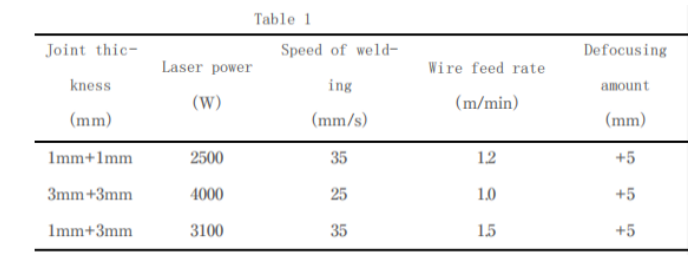
Results: The molding was good and the weld had no porosity, as shown in Figure 5.

Figure 5 Weld forming and cross section morphology
Narrow gap laser wire filling multi-pass welding
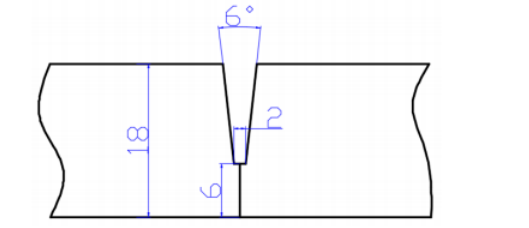
Requirements: 18mm thick Q345 Marine steel plate welded, requiring fewer weld holes, no non-fusion, joint tensile
The strength is higher than the base material, and the weld forming is better.
Equipment: RFL-C6000 (fiber core diameter 400μm), wire feeder, welding head.
Process parameters: the welding pass must be beveled, the size of the beveled is shown in Figure 6, and other welding process parameters are shown in Table 2.
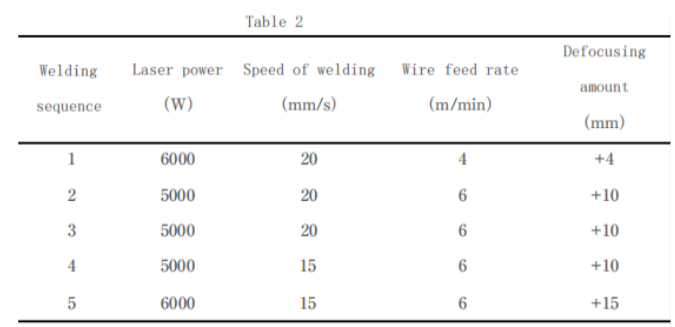
Figure 6 Groove size
Results: The molding was good, there was no non-fusion, and the weld basically had no porosity, as shown in Figure 7, and the tensile test was carried out
It is proved that the weld breaks in the base material, indicating that the tensile strength of the joint is higher than that of the base material.
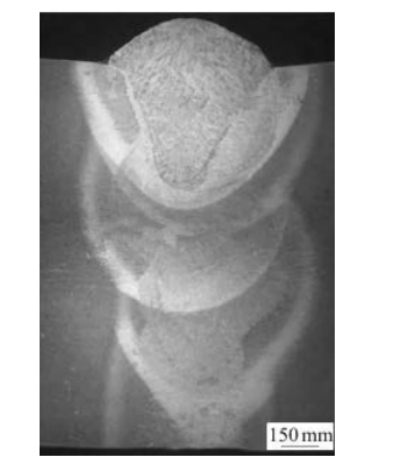
FIG. 7 Metallographic diagram of weld cross section
2. Equipment and process parameter suggestion
Improve weld forming and quality
For the butt joint laser wire welding of common materials, in order to improve the weld formation, it is generally recommended that the laser and fiber core diameter,
The welding head should be configured to ensure that the focusing spot diameter is between 0.4mm and 0.6mm, and the welding wire should be selected with the appropriate grade.
Other welding parameters are shown in Table 2 and Table 3.
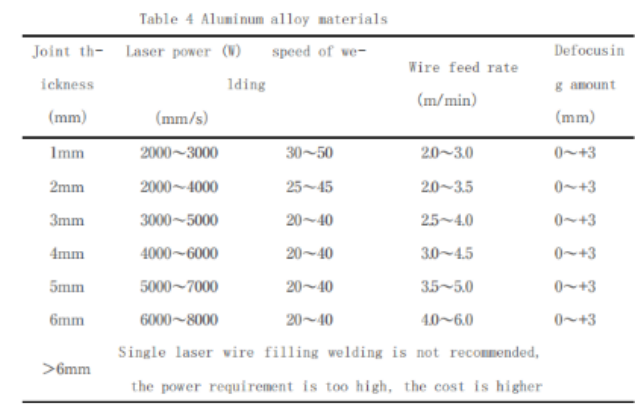
Narrow gap laser wire filling multi-pass welding
For the narrow gap laser wire filling multi-pass welding of medium thick plate, it is generally recommended that the focusing spot diameter is 0.6mm ~ 1.0mm, and
And the welding wire should choose the appropriate grade, in addition, the joint groove size must be reasonable design, groove size can not be too large,
Otherwise, it is easy to cause non-fusion inside the weld, and the general recommended groove size is shown in Table 5; The number of bead should be based on the joint maximum
Large thickness to determine, the first bottom weld is recommended to use the maximum welding capacity of the equipment to determine, after each depth of one
Generally 3mm ~ 5mm; As for the welding process parameters used for each bead, it is necessary to rely on its required welding depth and when
The width of the front weld pass is determined. When the width of the weld pass is larger, the defocusing amount should be increased moderately to prevent the side wall from failing to fuse.
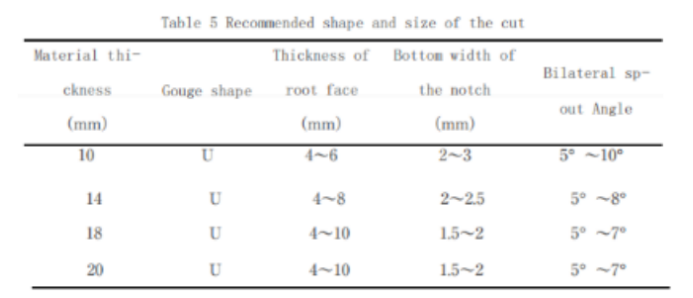
Post time: Apr-03-2025


















